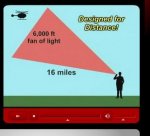RubberFrog
Rear Admiral
- Joined
- Apr 9, 2005
- Messages
- 4,268
Re: Laser as a rescue aid?
My apologies. I didn't realize your position was so tenuous, nor your sensitivities so fragile, that you couldn't withstand an alternate opinion.
Its not like this is a private forum, where you are whispering to a few buddies in the back corner. It's right out here in the open for anyone to comment on. That's how forums work.
I think we all saw your link to the lasr thingamajiggy. What aout that automotive "tornado" device, is that also legitimate simply because it is marketed?
PS: Rather than see you die in the sea, I would prefer that you would use a time tested rescue device such as a strobe beacon. How are you going to use a laser if you are unconscious?
My apologies. I didn't realize your position was so tenuous, nor your sensitivities so fragile, that you couldn't withstand an alternate opinion.
Its not like this is a private forum, where you are whispering to a few buddies in the back corner. It's right out here in the open for anyone to comment on. That's how forums work.
I think we all saw your link to the lasr thingamajiggy. What aout that automotive "tornado" device, is that also legitimate simply because it is marketed?
PS: Rather than see you die in the sea, I would prefer that you would use a time tested rescue device such as a strobe beacon. How are you going to use a laser if you are unconscious?




















